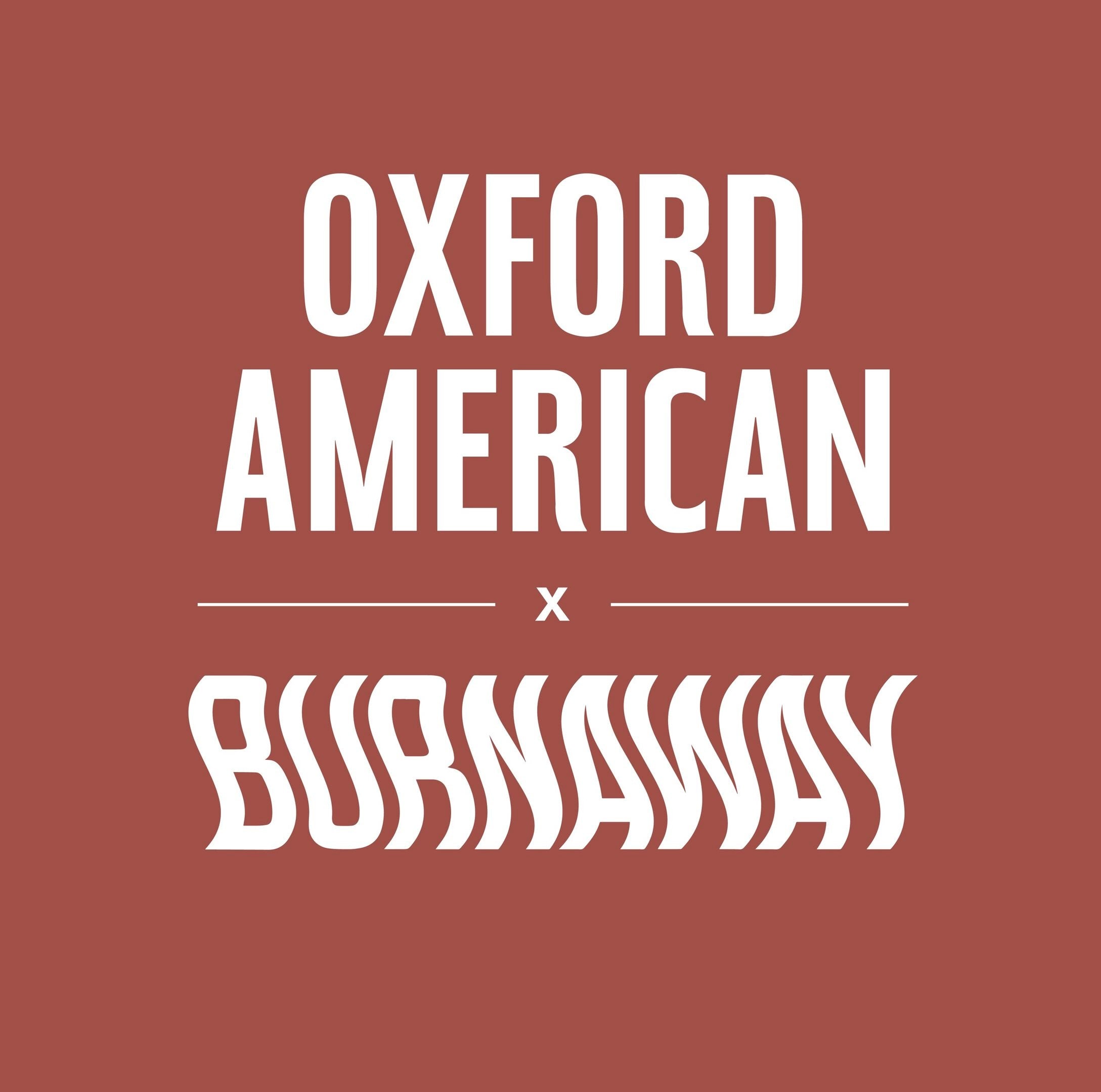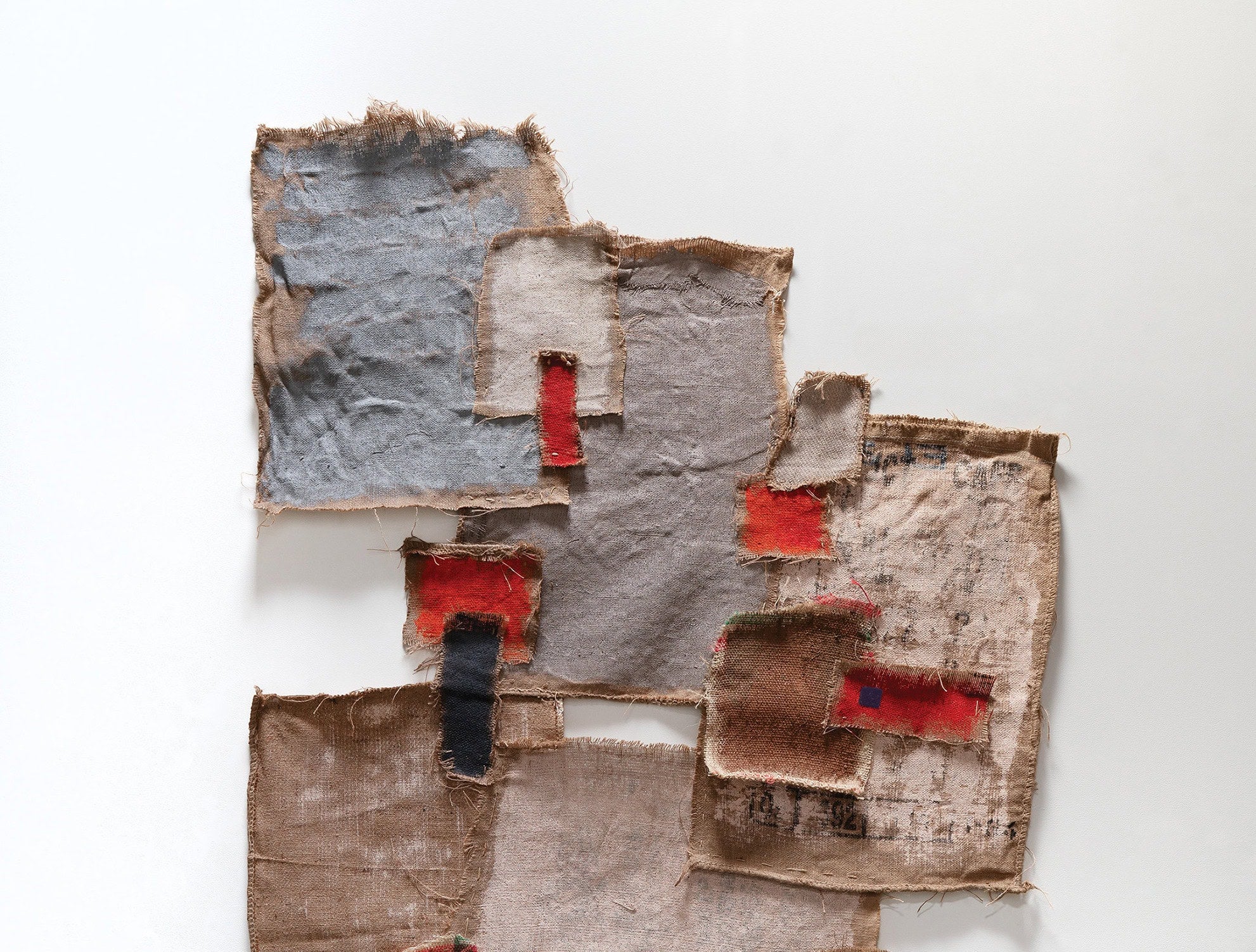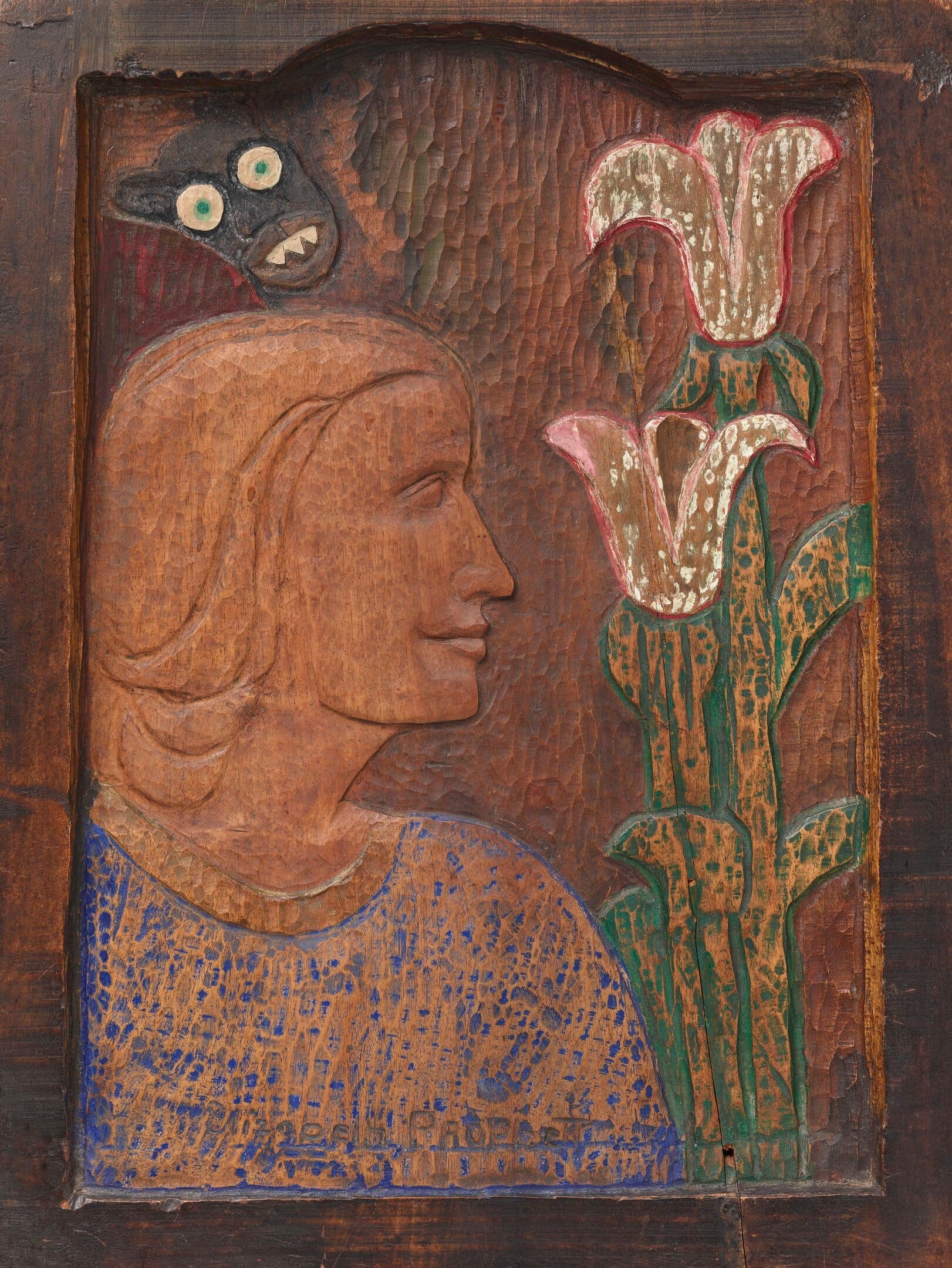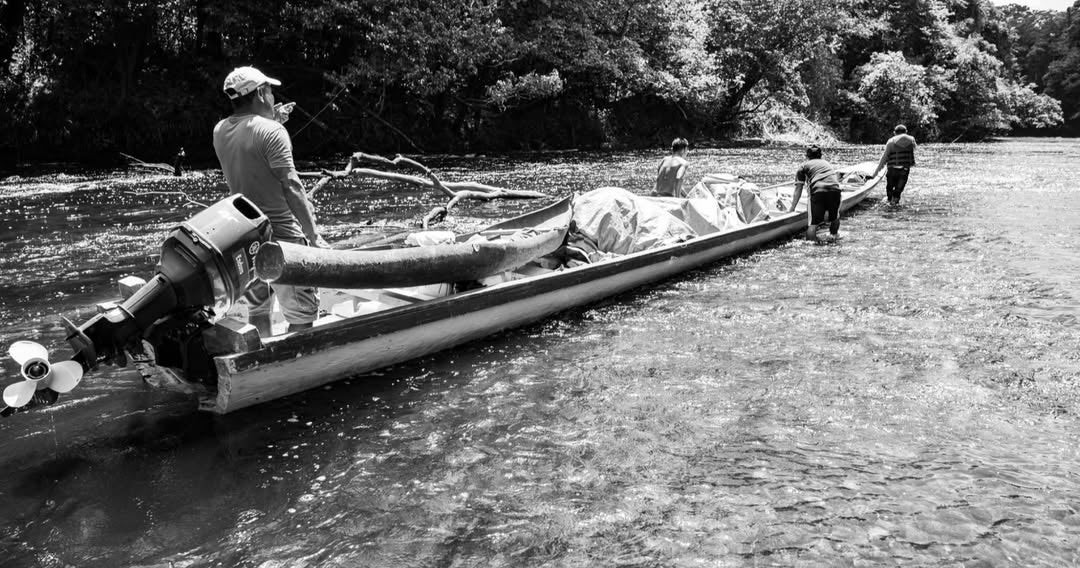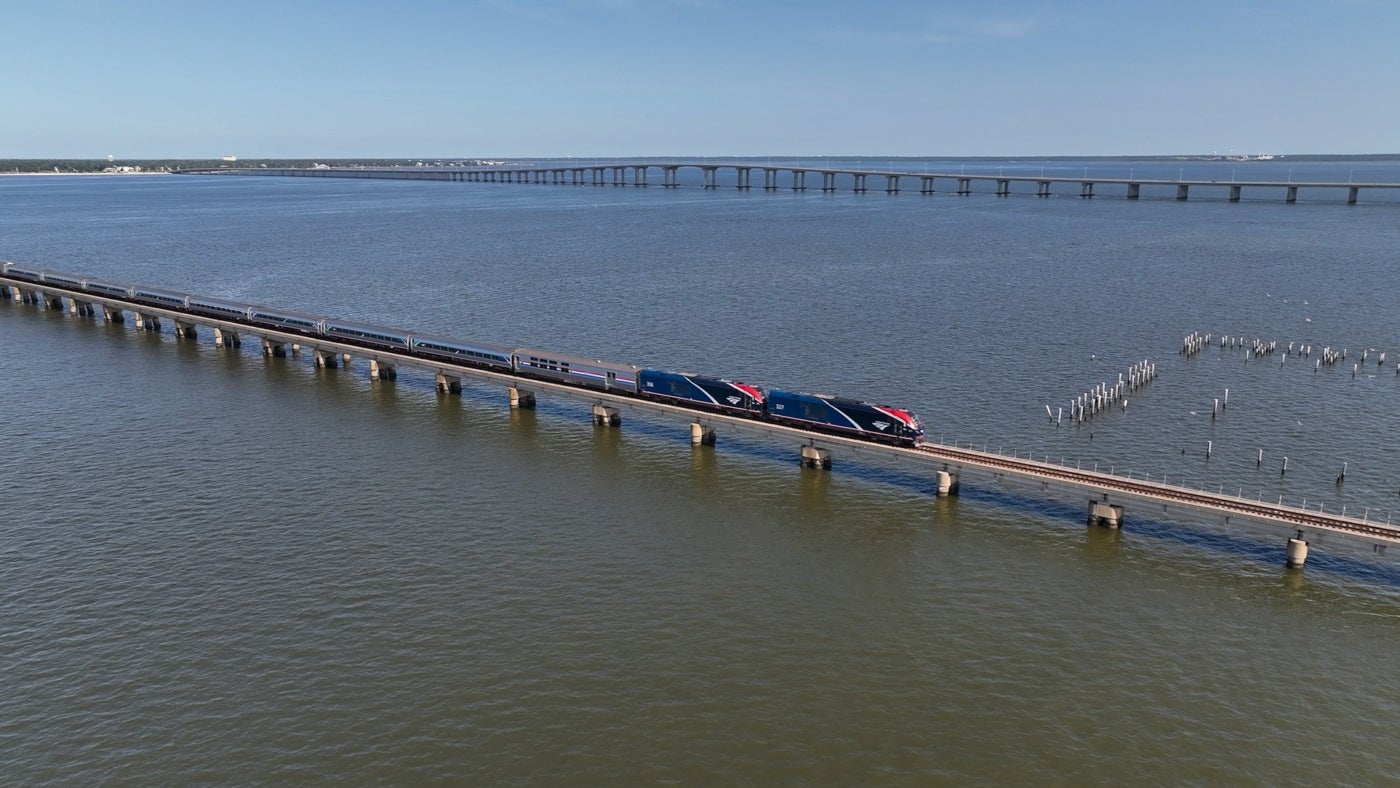
The train passengers are quiet as the morning sun rises over the marsh. Outside the window, land and water mingle in the tall grass, the steel of the train tracks the only trace of the definite amidst the murky shallows of the Gulf. It was still early when the train rolled out of New Orleans, and passengers are content to yawn and look out in silence while passing briefly through this watery world. Herons take flight as the lilac sky brightens, and lone cypress trees keep vigil at the edges of the disappearing land.
The early morning reverie lasts until the first stop at Bay St. Louis, Mississippi, where an exceptionally fabulous group of women climbs aboard, their brightly printed attire crisp with freshly ironed edges. As they settle in, the conductor comes on the loudspeaker to wish a happy birthday to the woman dressed in pink and wearing a fuchsia birthday sash. Her entourage cheers and claps. The energy is contagious. As the train trundles towards Gulfport, the cafe car grows busy, and more than a few patrons walk away from it with Bloody Marys in hand. It’s the Amtrak Mardi Gras Service line, after all, and its general mood is revealed by 9:00 a.m.: this train is a moving party as much as it is transportation. But like its namesake, this party carries historical weight. The decades-long struggle to maintain a passenger rail service within the culturally intertwined Gulf region went from difficult to almost completely futile after Hurricane Katrina. But thanks to a tri-state effort, the Mardi Gras line, which opened in August, is helping the Gulf return to itself.
“It’s a special region,” says Stephen McNair, the Director of External and Governmental Affairs for the city of Mobile. “When you look at the heritage Catholic traditions like Carnival, the coastal ecology, and all the cultural intangibles that come together, this region is unlike the remainders of their states.” McNair speaks from experience, having lived in both New Orleans and Mobile, and his preoccupation over tying the region together has been a main driver in his work with the Southern Rail Commission, the tri-state organization to which the Mardi Gras line owes its success. “Us coastal cousins have always been kindred spirits,” he says. “Reconnecting is an obvious choice.”
But while the need may have been obvious, the road to completion was steep. Start to finish, the passenger service is short enough for a good day trip, though it cuts through three states, beginning and ending in New Orleans and Mobile and passing through the Mississippi coastal towns of Bay St. Louis, Gulfport, Biloxi, and Pascagoula along the way. Getting the Mardi Gras line up and running was a complex process that required close collaboration between stakeholders as diverse as state and municipal governments, the Alabama Port Authority, federal commissions, and both freight and passenger rail companies. Almost unanimous agreement is required, as proven by the failure of two previous attempts to continue the Gulf Coast passenger service.
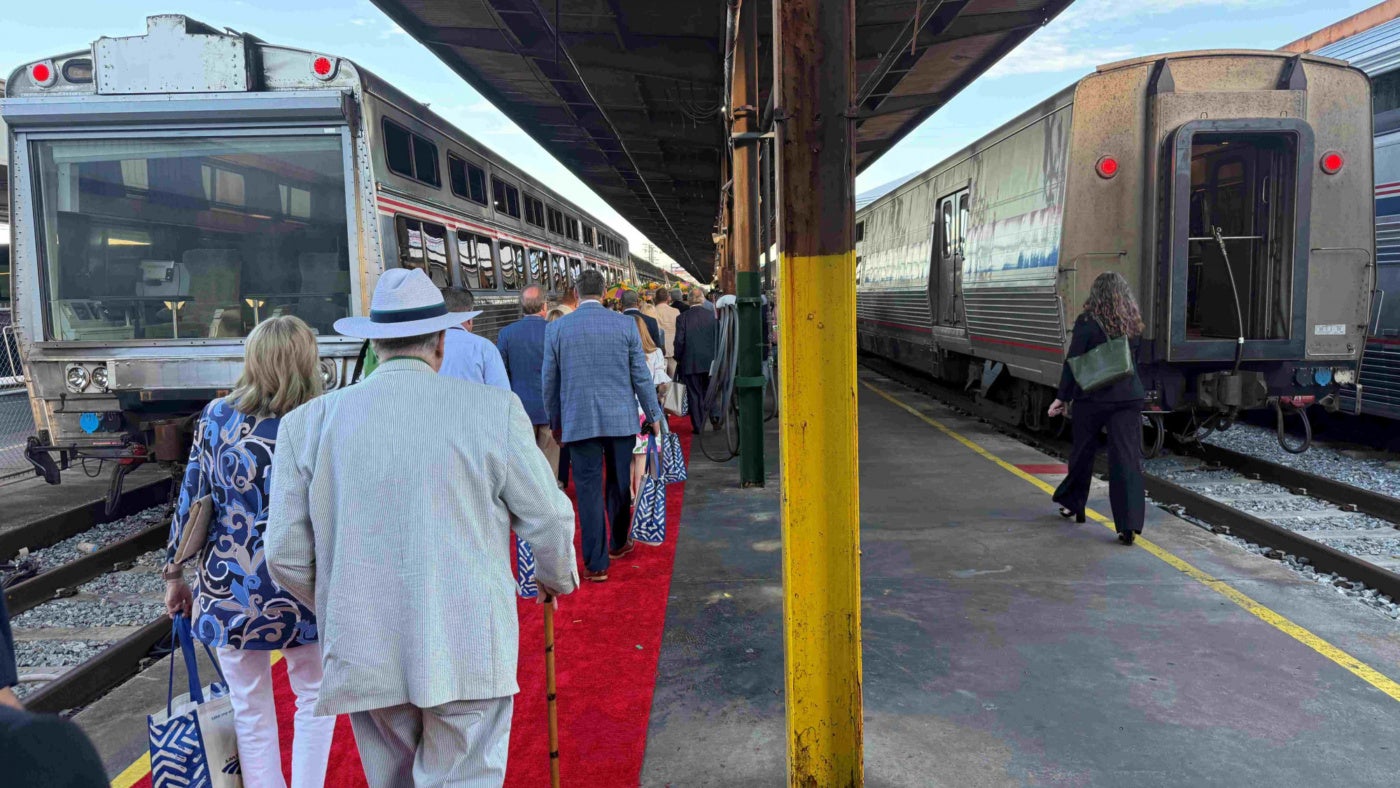
The failure of passenger trains was never caused by a lack of demand.
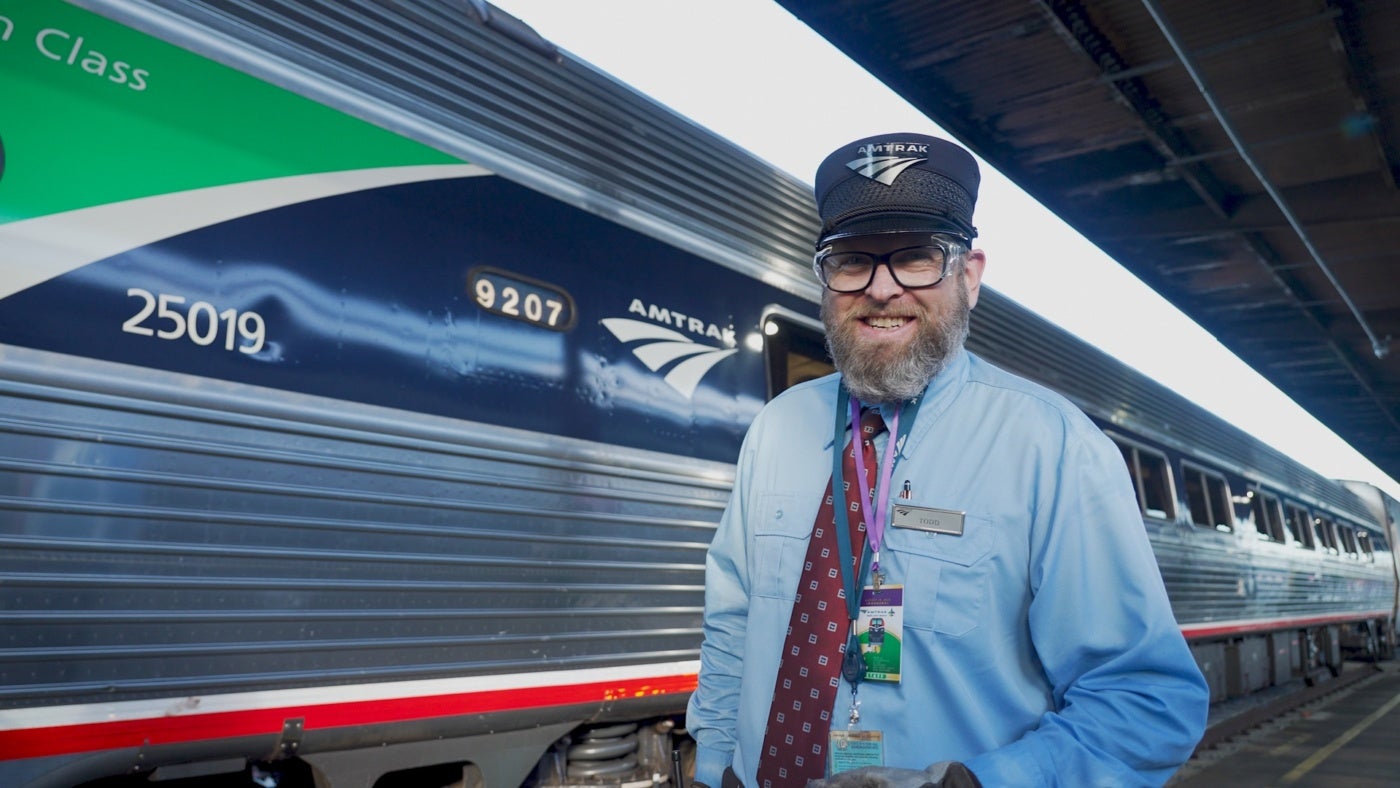
For many, the renewed passenger service is a long-awaited dream; in the past few decades, the car-bound region has offered few alternatives for those wishing to avoid the frequently congested I-10 highway. Though state governments might have claimed otherwise when it came time to invest, the failure of passenger trains was never caused by a lack of demand. The first short-lived attempt for a Gulf Coast passenger line was sparked by the 1984 World’s Fair in New Orleans. It proved popular but was shut down a year later after the federal government halted subsidies to the line and the state of Mississippi withdrew its support. In 1996, the Gulf Coast Limited line was revived, and ridership again surpassed the projected numbers. But when it came time to put up the money to keep it going, all three states declined to offer additional support, and in 1997 the line was discontinued. After Hurricane Katrina, the longer passenger line that ran through New Orleans and Mobile and into the Florida Panhandle sustained infrastructural damage. The rail lines became the exclusive domain of freight companies, and the future of the passenger rail in the Gulf South was looking permanently bleak.
Talking to the Price sisters and their friends, the boisterous group making their way to Mobile to celebrate Dianne Price’s seventieth birthday, it is clear that whoever is still trying to make the case that Gulf Coast residents just aren’t interested in train travel has their work cut out for them. Nor can it be said that passenger service is some kind of “joyride for the affluent,” as Mobile councilmember Joel Daves described the Mardi Gras line during a City Council debate. “The train has always been for everyone—it’s not expensive,” says Nefertiti Price, the youngest sister of ten. “It’s time they start building more ways for the people to travel.”
For Sandra Price, the self-appointed organizer of the sixteen-person day trip to Mobile, accessibility was part of the line’s appeal. With ticket prices starting at fifteen dollars each way, it was an activity that everyone could afford, while accommodating the varying needs of an adventurous group of women aged fifty to eighty-two. The train works equally well for those with limited mobility, freeing the whole group to focus on enjoying their time together. “We’re now in our comfort years, and we’re always looking to find things we didn’t know about to add to our ‘like list,’” she says, declaring that the Amtrak Mardi Gras line, which she refers to as the “Birthday Soul Train,” has just shot to the top. Dianne’s seventieth birthday party celebrants are having so much fun, Sandra feels there are no adequate words to describe it. “We’re so grateful—no, railful. Yes, railful is what we are,” she says. “Next time we ride, we’re going to New Orleans.”
The sisters’ excitement is what McNair sees as one of the positive impacts of this train line that may be hard to measure but is nevertheless a vital part of the equation. “There’s a certain intangible quality of riding this particular service that increases quality of life and is about more than getting from point A to point B,” he says. Walking from car to car, this truth is visible everywhere. A mother and son are taking their Mobile excursion thanks to a St. Tammany Parish school holiday, and he finds a new seat in a different car every few minutes, determined to take it all in.
Anyone lingering around the cafe will discover that the Price sisters are not the only ones on board celebrating a birthday. Three men have made headquarters at a cafe car booth by the window, and they inform me that they drove down to the New Orleans train station from Baton Rouge to celebrate one of their birthdays. As I look closer at the papers strewn across their table, they invite me to sit down and offer me a sheet. It’s an Amtrak Mardi Gras Service line-themed Bingo card that they’ve put together themselves, and it includes items such as a cypress tree, a casino billboard, and the expression, “All aboard!” (They’d asked the conductor to say that line, and he was happy to oblige.) I begin to mark up my own Bingo card, and I ask them what had inspired them to make it. “We wanted to show our support for this line,” says Guy Pittman. As retirees, they are hoping for the expansion of passenger service throughout the South, which they know has been an uphill battle.
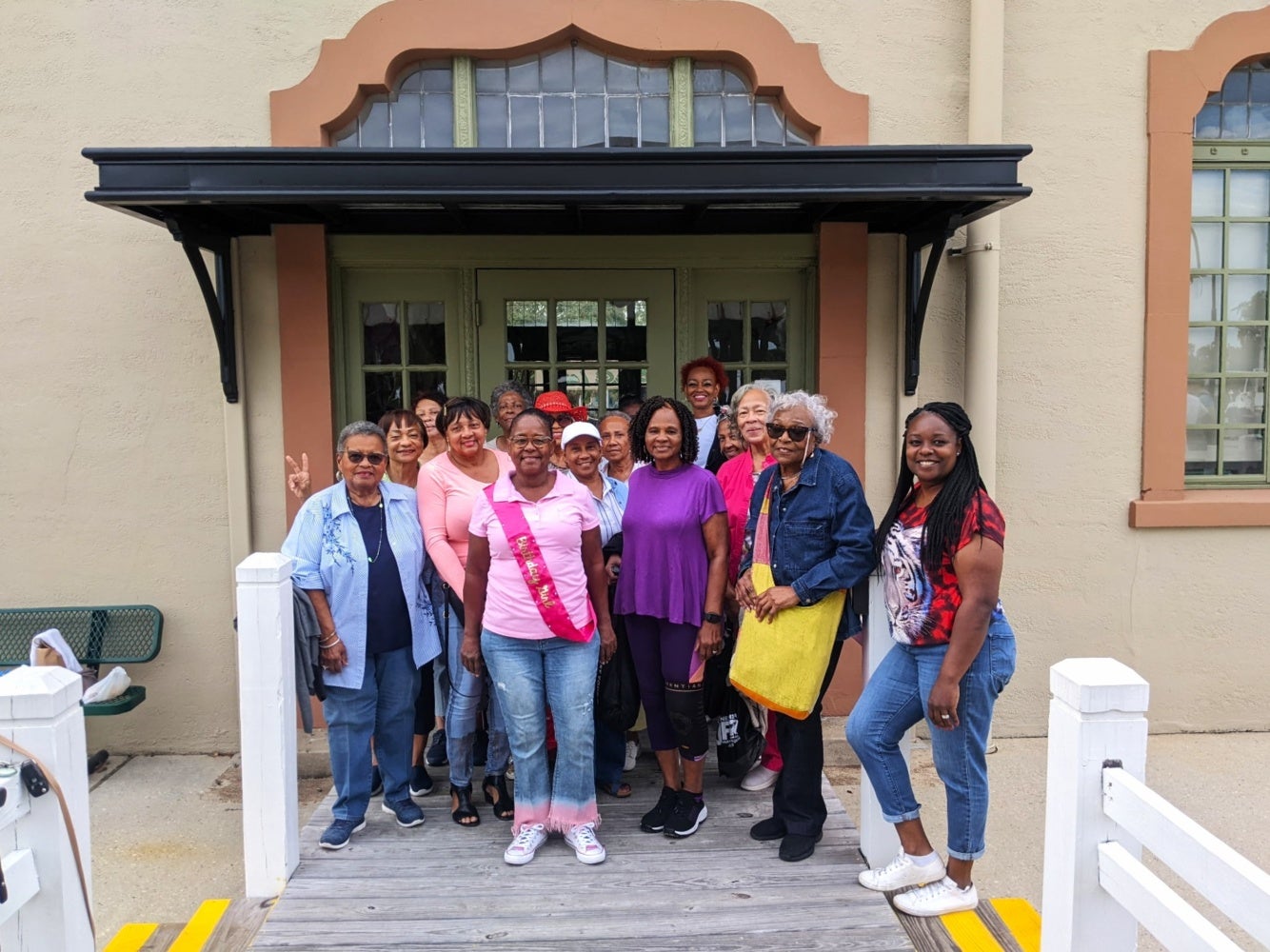
The biggest obstacle has been the priority given to freight trains, causing the major delays that have earned Amtrak a reputation for being unreliable. But this is changing.
The struggle of the Gulf Coast Limited is a typical story of American train travel. Though the United States has the largest rail network in the world, ridership often falls far below that of our counterparts abroad. Though the true causes of the post-World War II downturn in ridership are a matter of some debate. When the decline reached a crisis point in the 1960s, trains were often assumed to be a casualty of advancements in roadway infrastructure and air travel.
But for those who believed that trains should remain an important intracontinental connector, this was a dangerous fallacy. In his 1964 plea “Why Kill the Passenger Train?,” transportation expert Stanley Berge wrote, “One of the most confusing of the American transportation myths is the notion, widely bandied about, that whenever a railroad hauls freight it makes money and that whenever it hauls passengers it loses money.” If trains were dying, he argued, it was not because they had outlived their usefulness, but because the industry had grown corrupt. “The passenger train is in mortal danger—not from its rivals, the automobile, the bus, and the airplane—but from its friends, the railroads and the Interstate Commerce Commission.” With freight companies reigning supreme over the country’s rail systems, the US would have to act quickly if they didn’t want to lose passenger service for good.
Enter Amtrak. Founded in 1971 as a quasi-public corporation to stay the execution of passenger service, the company has faced myriad challenges in their attempt to provide the level of quality that, in other countries, keeps train travel competitive with other forms of transport. The biggest obstacle has been the priority given to freight trains, causing the major delays that have earned Amtrak a reputation for being unreliable. But this is changing. In September, the Department of Justice ruled in favor of granting priority of the Crescent Route, which serves thirty-three Southern cities, to Amtrak passenger trains, requiring the freight corporation Norfolk Southern to comply with a variety of shifts intended to reduce the delays that had long plagued Amtrak’s service along the line.
According to McNair, the relationship between freight and passenger companies has grown increasingly amicable as the Mardi Gras line project has picked up momentum, gathering more and more allies along the way. “Once the larger CRISI [Consolidated Rail Infrastructure and Safety Improvements] grant was secured, the freight carriers and the Port of Mobile were much more open,” he says, noting the concerns of a major shipping hub that pleasure riders would interfere with commerce. “The last thing the city of Mobile wanted to do was to introduce a service that would impede the economy, so ensuring that all parties can succeed was paramount.”
Projects requiring close collaboration by a diverse group of stakeholders can be a risky activity in a political moment as polarized as this one. With every aspect of government growing increasingly politicized, it’s rare to reach consensus. An emphasis on expanding passenger service during the Obama administration made train transportation a target of conservative opposition. But during his tenure as Secretary of Transportation under the Biden administration, Pete Buttigieg proved eager to make infrastructure funding available for rail expansion, allowing Gulf Coast politicians to see potential rather than political bait.
One of the project’s major advocates, Republican Senator Roger Wicker from Mississippi, spearheaded the Mardi Gras line project, having secured billions of dollars in funding as a member of the Senate Committee on Commerce, Science, and Transportation. At the August 18 opening ceremony for the Mardi Gras line, Senator Wicker underscored both the bipartisan effort and the sheer persistence it took to make it all happen. “In the Senate, I spent nearly ten years securing federal investment, continuing conversations with stakeholders, and pressing Transportation Secretary nominees and federal rail officials about their commitment to Gulf Coast rail,” reads his statement. “At last, passenger rail has returned to the Mississippi Gulf Coast. In 2005, Hurricane Katrina shuttered the line that carried tourists and travelers along our shore. Today, after 20 years of effort, that changes.”

“On the inaugural run they ran out of alcohol before we got to Bay St. Louis.” — Kay Kell, Member of the Southern Rail Commission

By all accounts, the maiden voyage of the Mardi Gras Service line was an affair to remember. Given how many people are involved in a project this expansive across three states, the cars were packed and the mood was celebratory. Southern Rail Commission member Kay Kell put it succinctly: “On the inaugural run they ran out of alcohol before we got to Bay St. Louis. We told them [the drinking] would be heavy, but they didn’t believe us.” It doesn’t take much reading between the lines to figure the group was pretty cooked by the time they reached Mobile. There, the regional rivalry concerning whose Mardi Gras came first, and who does it best, was set aside as representatives of the New Orleans Mardi Gras royalty met their Mobile counterparts in a jubilant scene backed by live jazz music.
As a proud Bay St. Louis resident, Kell sees the festivities on board as a perfect example of the Gulf Coast spirit, a cultural gem that the train will provide outsiders better access to. “I’ve done a lot of traveling internationally, and wherever you are, you check the train routes to see where you can go from there,” she says. “With tourists coming into New Orleans from all over, there’s now all these local places they can access. The coast is open and fun loving—we’ll pick you up in a golf cart, bring you a Bloody Mary, and take you where you want to go.”
It’s hard to know whether or not she’s exaggerating, until you talk to Andrew “FoFo” Gilich, the mayor of Biloxi, whose contribution to the inaugural run of the Mardi Gras line was “100 pounds of shrimp, cooked right.” During the first week of service, Gilich saw ten people disembarking at Biloxi, and he stopped his municipal SUV right in front of them. “Welcome to Biloxi. I’m the mayor,” he told them. “Get in the car, and I’ll show you around.” They did, and from the way he extolls Biloxi’s virtues (and vices), it’s hard to imagine a better tour guide. “Not too many cities are 320 years old—we’ve had time to get it right.” A longtime supporter of the project, he echoes the importance of regional unity. “Coastal people all have the same DNA, we share a way of life,” he says.
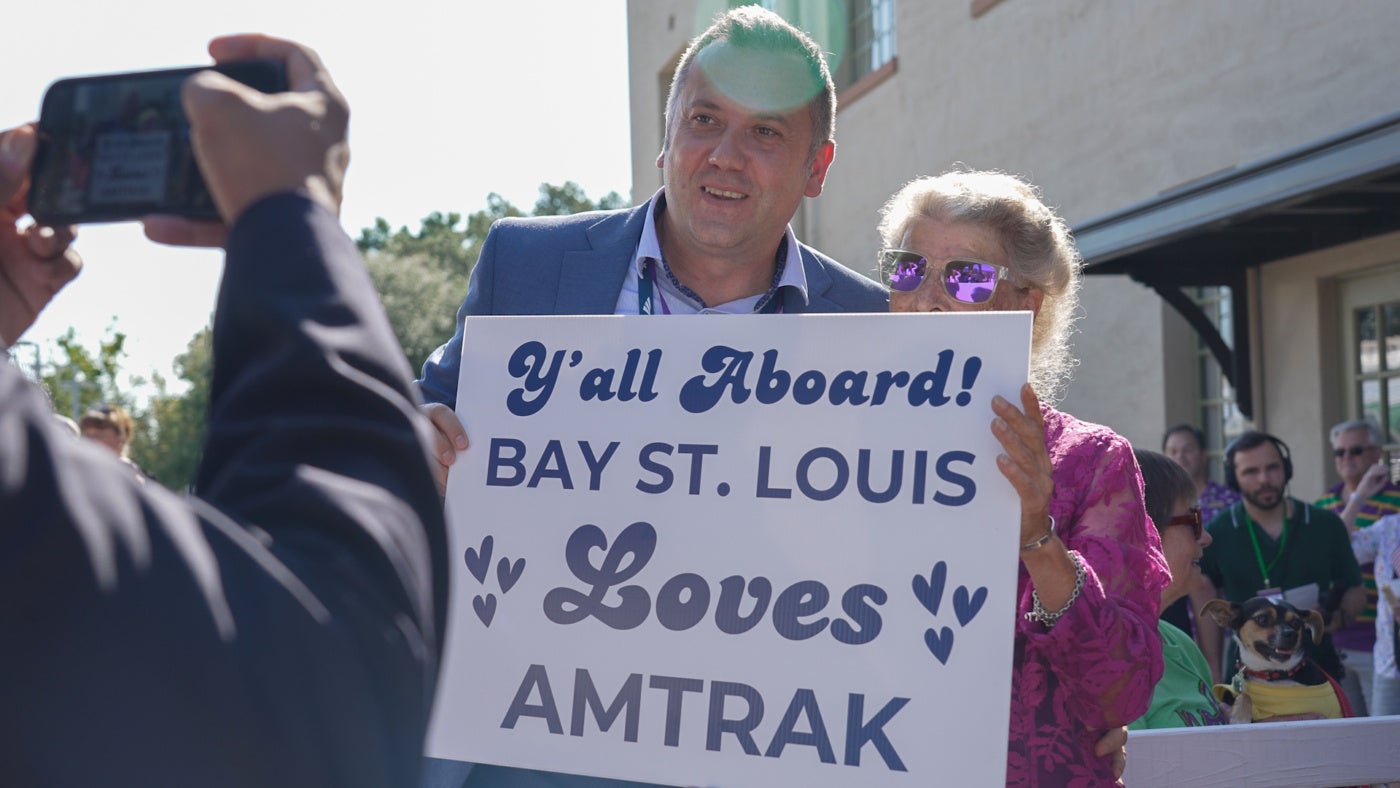
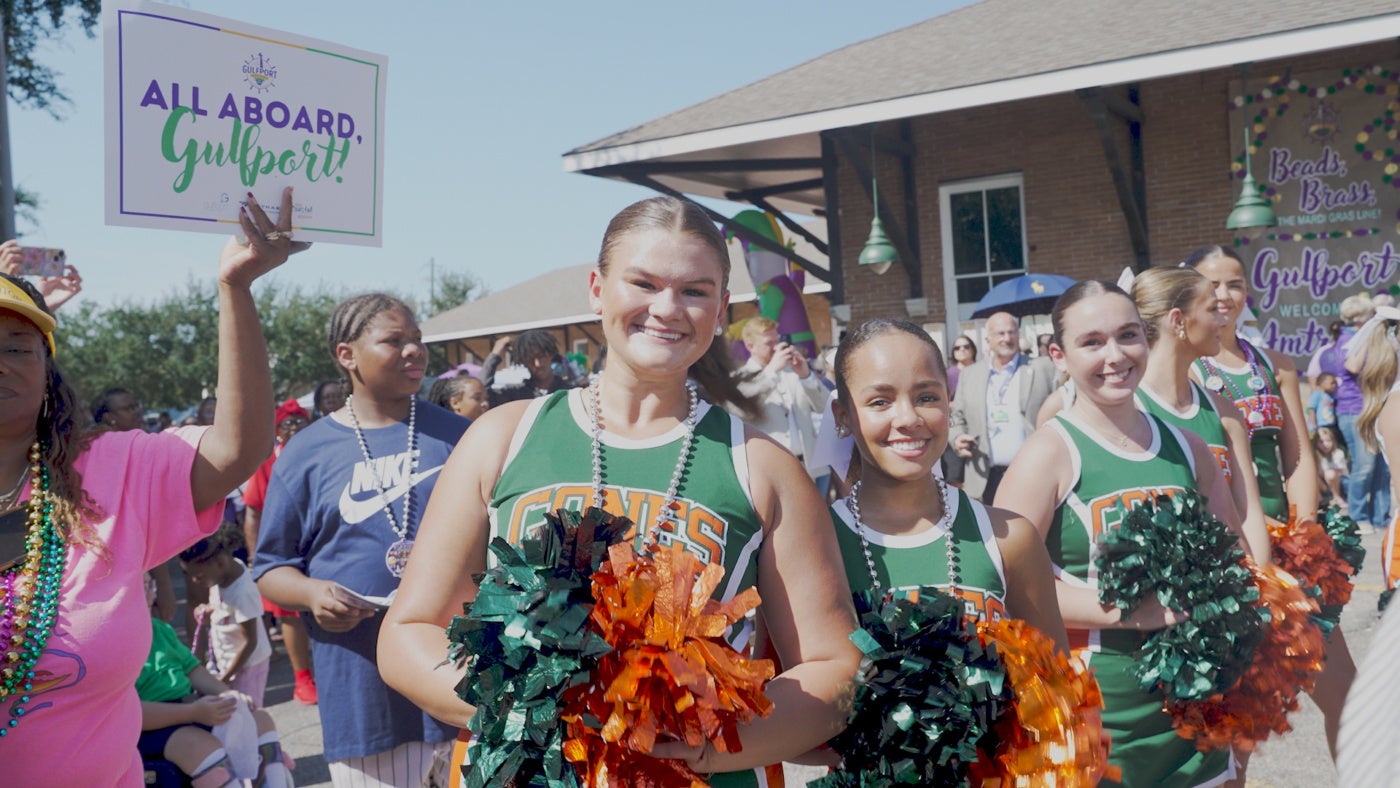
According to Kell, the idea to name the passenger service the Mardi Gras line initially ruffled feathers. But the naysayers were swiftly overruled. “We named it the Mardi Gras line because we wanted to capture that feeling of fun. We got a little pushback at first, but the truth is that is our culture—so come and enjoy it.” she says. And though she is a strong proponent of the regional philosophy of “party-as-a-way-of-life,” she sees the more practical possibilities of connecting rural and urban areas. She mentions how many elders will now be able to access medical care without driving, or as is sometimes even more challenging, finding someone to take them.
Mayor Gilich jokes about the mental health benefits of the train, for himself above all. “You may have noticed I’m a AA personality. I’m always going a hundred miles an hour,” he says. “But the train relaxes you. I’m telling you—the birds, Honey Island Swamp, you won’t get a chance to see any of that by driving through it.”
Coming back from Mobile, passengers from the morning train greet each other like old friends and settle in to watch the sunset over the bayou on the way home. They are joined by plenty of newcomers, who by the sound of it are headed to New Orleans for the night. There’s a bumping speaker getting the party started in the last car. As the sky grows darker, someone passes a bottle of whiskey around, and the laughter grows increasingly raucous. With scarcely a window seat left, it’s easy to believe the reports that the Mardi Gras line has surpassed even the most optimistic ridership predictions. During Saints games, a whole car is added to accommodate all the extra riders, but the line still sells out. Walking from car to car, I see the makings of yet another tradition that Gulf Coasters will obstinately hold onto, come hell or high water.


